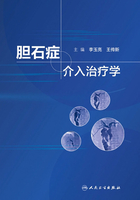
参考文献
1.Kimura Y, Takada T, Kawarada Y, et al. Definitions, pathophysiology and epidemiology of acute cholangitis and cholecystitis: Tokyo guidelines. J Hepatobiliary Pancreat Surg, 2007, 14: 15-26.
2.Haffner SM, Diehl AK, Mitchell BD, et al. Increased prevalence of clinical gallbladder disease in subjects with non-insulin-dependent diabetes mellitus. Am J Epidemiol, 1990, 132: 327-335.
3.Farthing M, Roberts SE, Samuel DG, et al. Survey of digestive health across Europe: final report. Part 1: The burden of gastrointestinal diseases and the organisation and delivery of gastroenterology services across Europe. UEG J, 2014, 2: 539-543.
4.Portincasa P, Moschetta A, Palasciano G. Cholesterol gallstone disease. Lancet, 2006, 368: 230-239.
5.Tsai CJ, Leitzmann MF, Willett WC, et al. Statin use and the risk of cholecystectomy in women. Gastroenterology,2009, 136: 1593-1600.
6.Tsai CJ, Leitzmann MF, Willett WC, et al. Central adiposity, regional fat distribution, and the risk of cholecystectomy in women. Gut, 2006, 55: 708-714.
7.Mendez Sanchez N, Gonzalez V, Aguayo P, et al. Fish oil (n-3) polyunsaturated fatty acids beneficially affect biliary cholesterol nucleation time in obese women losing weight. J Nutr, 2001, 131: 2300-2303.
8.黄志强.对我国胆道外科几个焦点问题的思考.外科理论与实践,2001,6 (01): 3-5.
9.张禹.胆囊结石治疗的新趋向.中国乡村医药,2009,16 (01): 4-5.
10.Klein S, Wadden T, Sugerman HJ. AGA technical review on obesity. Gastroenterology, 2002, 123: 882-932.
11.Stinton LM, Myers RP, Shaffer EA. Epidemiology of gallstones. Gastroenterol Clin North Am, 2010, 39: 157-169.
12.Willett WC, Dietz WH, Colditz GA. Guidelines for healthy weight. N Engl J Med, 1999, 341: 427-434.
13.Stender S, Nordestgaard BG, Tybjaerg-Hansen A. Elevated body mass index as a causal risk factor for symptomatic gallstone disease: a mendelian randomization study. Hepatology, 2013, 58: 2133-2141.
14.Krawczyk M, Wang DQ, Portincasa P. Dissecting the genetic heterogeneity of gallbladder stone formation. Semin Liver Dis, 2011, 31: 157-172.
15.Torti KL, Brach JS, FitzGerald SJ, et al. Physical activity and decreased risk of clinical gallstone disease among post-menopausal women. Prev Med, 2005, 41: 772-777.
16.Banim PJ, Luben RN, Bulluck H, et al. The aetiology of symptomatic gallstones quantification of the effects of obesity, alcohol and serum lipids on risk. Epidemiological and biomarker data from a UK prospective cohort study (EPIC-Norfolk). Eur J Gastroenterol Hepatol, 2011, 23: 733-740.
17.Ruhl CE, Everhart JE. Association of diabetes, serum insulin, and C-peptide with gallbladder disease.Hepatology, 2000, 31: 299-303.
18.Biddinger SB, Haas JT, Yu BB, et al. Hepatic insulin resistance directly promotes formation of cholesterol gallstones. Nat Med, 2008, 14: 778-782.
19.Walcher T, Haenle MM, Mason RA, et al. The effect of alcohol, tobacco and caffeine consumption and vegetarian diet ongallstone prevalence. Eur J Gastroenterol Hepatol, 2010, 22: 1345-1351.
20.Chen LY, Qiao QH, Zhang SC, et al. Metabolic syndrome and gallstone disease. World J Gastroenterol, 2012,18: 4215-4220.